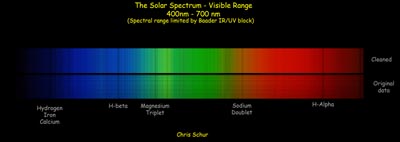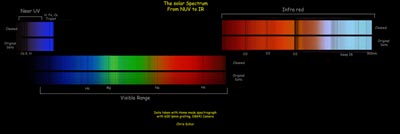|
This pair of images
illustrates the increase in resolution (about 4 Angstroms FWHM)
with the 600 lpmm grating installed. It took 9 frames to fully
cover the spectrum from UV to IR. The color images were taken
with our brand new DBK41 camera from Imaging Source, and shows
the spectral lines against a stunning backdrop of the colors
of the rainbow.
The image on the
left was taken through a Baader IR/UV blocking filter, which
constrains the range from about 400 to 700nm which is the range
that the eye can see. The image on the right I've extended the
range on both ends by removing the blocking filter and recording
the near UV and the IR to 900nm in the IR. As you can see, the
color camera has a peculiar response to IR. This is due to the
leakage of IR in the different Bayer mask filters over the chip
that produce the normal colors.
Click on the largest
images to see all the lines, many of them are very narrow and
you can pan back and forth with the scroll bars on your browser
to see the whole length!
 800 x 600
800 x 600
1600 x 1200
I've marked the
primary absorption lines here, there are hundreds of them across
the spectrum marking the traces of elements in the Suns outermost
atmosphere. Two versions are shown. the bottom of the spectrum
is the raw data constructed from six sections right out of the
spectrograph. The upper section has been cleaned up using a standard
technique used by spectroscopists and more clearly shows many
of the faint bands in the spectrum.
|
 800 x 600
800 x 600
2400 x 800
A total of 9 panel
were exposed and combined very carefully to produce this set.
The normal visual spectrum is on the bottom. The two extended
spectrums on the top are what additional wavelengths you get
when you remove the Baader IR/UV blocker and are beyond normal
visual range. In the UV on the left, you can faintly see the
Calcium K and H lines on the extreme left end. On the right IR
extension, the super dark bands are from Oxygen in Earths atmosphere
being superimposed on the Suns spectrum. They are very detailed
and complex! On the right side I ended around 900nm because the
spectrograph tilt mechanism bottomed out. The spectrum gets very
dim out there.
|
|